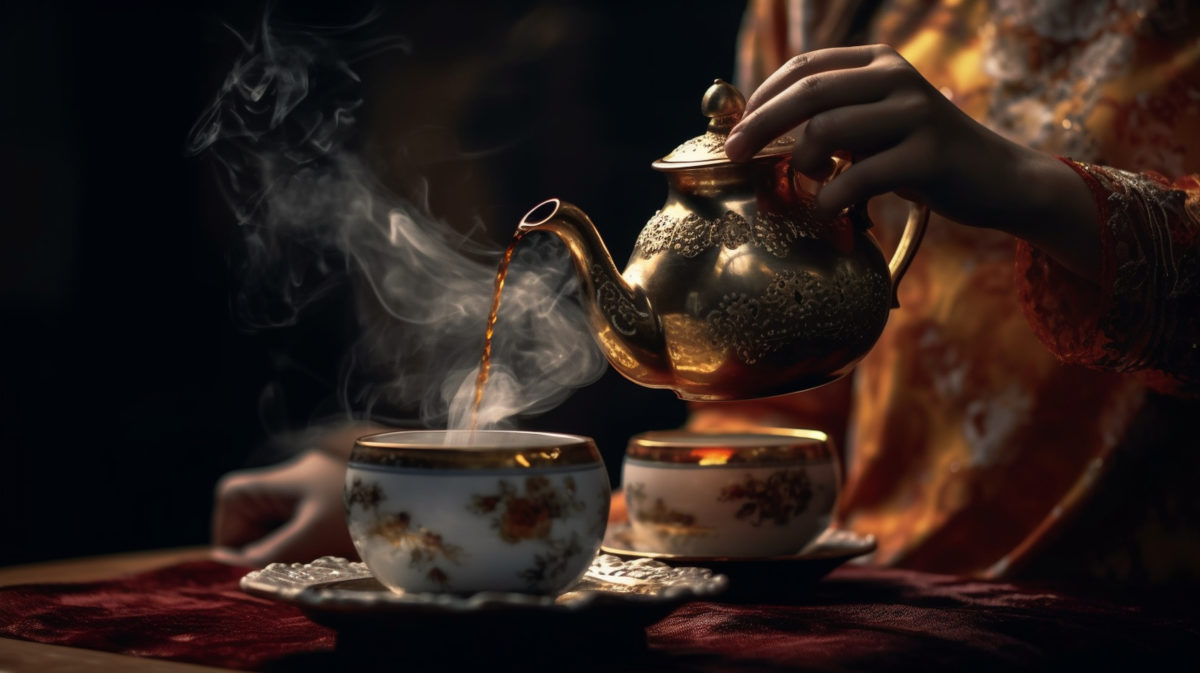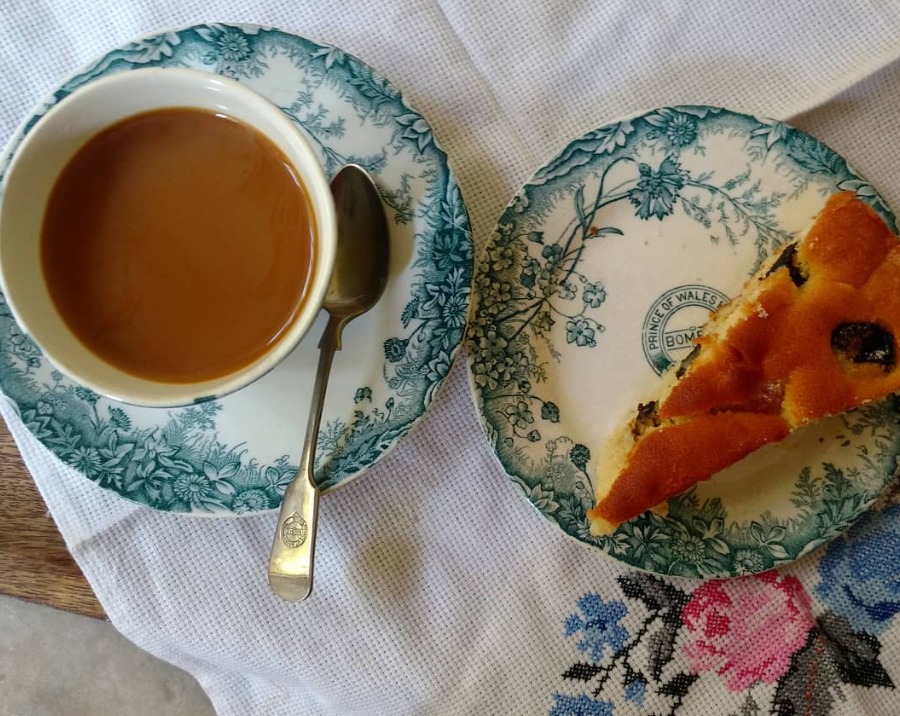
My earliest memory of using the kitchen stove goes back to my very happy childhood. I was three years old when I would stand on a stool and boil water (under the supervision of our cook, Parvati) to ‘make’ tea for my parents. Thus, the first thing I learnt to cook was tea.
Parsis call tea choi, not chai, cha, or tea but choi. It is a very religious thing to the community, and there are wars about how to make it and what goes into it. My dad’s family was from Fort, the southernmost part of Bombay and the most anglicized. We had choi that was steeped in a bone china teapot with milk and sugar in their respective receptacles on a tray. The teapot was covered with a tea cozy, usually in a cover embroidered by my late grandmother. The tea was Assam. My grandfather preferred Brooke Bond, with loads of mint leaves (fudno) and chopped segments of lemongrass or ‘leeli choi.’ The leaves were all placed in the teapot, and boiling water was poured over them, and it would all steep for a few minutes. The tea was light, a wee amount of milk was added, and at least a full teaspoon of sugar would go into each cup. The cups and saucers were always bone china. Very often, Chinese bone china.
At my maternal grandmother’s house in the sylvan surrounding of an as yet un-urbanized Bandra, my granny made tea by boiling milk and water with lemongrass and mint and adding the tea leaves just as the milk came to a boil, a brief simmer, and tea was poured out for all. Sugar had a permanent place on the dining table, and everyone helped themselves to as much as they wanted. The cups were assorted and often mismatched. If we were very lucky and someone had just returned from a trip to Udvada, the holiest Parsi Fire Temple, there would be the added flavor of peppermint leaves, transforming the very regular choi into something incredibly fragrant and special.
In summer, bunches of mint and chopped lemongrass leaves were sundried and bottled for the wet monsoon months. If there was a chance haul of peppermint, this, too, was dried and kept for special occasions. My granny had no fridge, you see, and the herbs had a short shelf life — this way she made sure that they got maximum returns from her purchases.

Choi was never, ever consumed on its own. There was always something with tea. Bhakras, the soft cookies made with dough fermented using palm toddy, would be made in bulk and stored in large aluminum tins. Bananas past their use by date would be turned into karkarias – fritters flavored with the Parsi sweet spice mix elchi-jaiphal (cardamom seed and nutmeg ground with sugar). Flat, mildly sweet pancakes called chaapat were also a regular member of the tea table. For special occasions, there were ghaari – thick dough discs filled with either a mixture of bananas cooked in ghee, dates cooked till gooey, or a sweet dal paste.
At my dad’s mum’s sister’s place in Lonavala, at least once a week, the tea time special was a date and walnut cake, often sans the walnuts.
If nothing else, bakery biscuits, salty batasa, khaari (baked puff pastry), naankhatai, wine biscuits, or coconut macrooms were laid out on quarter plates. If it was pouring heavily, bhajjias would often make an appearance, and if there were guests, sandwiches.
My mother loved hosting teas, and her chicken, egg, and chutney sandwiches were legendary. She also regularly served the fried overripe Rajeli bananas of Vasai, which all Parsis love. These would be bought in a large yellow bunch of a dozen or more and hung from a hook in the ceiling till they all turned black! They were then broken off, peeled, cut into one-inch segments, and shallowly fried in ghee. The outsides would be caramelized to crunchy goodness whilst the insides would be a custardy delight.
My mother loved experimenting with her tea leaves. She wasn’t content with the same old flavors. I still remember seeing tea in a tea caddy for the first time! It had an unforgettable story accompanying it. The blue box showed a Tibetan Lama standing in a hilly tea garden. The brand was called Runglee Rungliot. The story written on the back of the tin caddy said there was once a monk who set out to find the finest tea in the world, and when he came to this tea garden, he said -Runglee Rungliot – this far and no further! We also once rushed all the way to The Patisserie at the Taj to score a limited-edition Taj Mahal Editor’s Choice tea in a porcelain caddy. I don’t remember much about the tea, but the caddy was reused for many years.
My mum loved teapots and tea sets, and after she retired to Lonavala with dad, he once did an inventory and was shocked to find she owned 19 tea sets and another dozen or so teapots! The fact that he indulged her by buying them was conveniently forgotten.
Tea time was always an intense bonding exercise with family or friends. Tea, especially evening tea, could be a meal longer than any other. Sitting, talking, squabbling, or just ruminating together – that was tea time.
The Parsis are the descendants of Zoroastrian economic and religious refugees who left for greener shores after 130 years of Islamic rule (after the conquest of Sassanid Iran*). They landed on the southern coast of Gujarat. Adopted local language and customs all so they could hold on to their faith. As Persians, they were already well versed in drinking tea, as the Silk Route had brought tea to Iran much before it came to India. But the tea drinking they adopted wasn’t the tea liquor in small glasses, with or without mint leaves, with a small piece of sugar crystal by the side. It was the very poncy British variant with a wee drappie of milk. Though being Parsis, they happily added aromatic herbs like mint, lemongrass, and peppermint, and after living in Gujarat for 1,000 plus years, they were hardly having it unsweetened!
You can’t speak about Parsis and Tea without mentioning the Irani Cafes of Mumbai. The Iranis here are a small group descended from Irani Zoroastrian migrants to Mumbai who arrived in the middle of the 19th century. They were helped to come and settle here by the Parsis, and being bakers in their homeland, they set up teashops all over the city. A huge variety of bakery products and umpteen cups of tea were sold here. This tea was a pre-brewed tea liquor in a Samovar, which would be added to a cup with milk. Some places also served tea liquor in a small glass full of mint leaves with a cube of sugar by the side, very much like the tea shops of Iran. To cater to all in a very religious and caste-rigid era with commensality taboos – Hindus were served in pink cups, Muslims in green, and the rest (Jews, Christians, Europeans, and Parsis) in white. This disappeared in the 50s, and all are served in white hotel china. The heyday of the Irani Café has passed; from over 250, there are barely 25 today.
The Parsis, too, are a dwindling community, and intense urbanization and nuclear families now mean there isn’t much scope for long, languid evening or morning teas. Tea is usually a quick affair in the mornings or late evenings (after office), and the snacks are now often store-bought either from Paris Bakery, PAC, or RTI. But choi is still never drunk on its own. If nothing else, a slice of buttered bread or a biscuit or two is the very least one can make to ensure the choi isn’t alone.
*The Sassanid Empire was one of late antiquity’s most militarily, economically, and culturally powerful states. Yet, during the mid-Seventh Century, it fell before the relentless Arab Conquest. In 642, Umar ibn al-Khattab, then-Caliph of the Muslims, ordered a full-scale invasion of Persia by the Rashidun army, which led to the complete conquest of the Sasanian Empire by 651. – The Collector
Parsis Tea Sandwiches
Equipment
- 2 Medium pots
- 3 Mixing bowls
- 1 Cheese grader
- 1 Food Processor or mortar and pestle
Ingredients
Chicken & Egg Sandwiches
- 3 Boneless skinless chicken breasts or thighs
- 4 Eggs
- 1 cup Finely chopped celery
- 1 cup Mayonaisse
- 1 loaf Sliced high quality white bread
- Salt & pepper to taste
Chutney & Cheese Sandwiches
- 1 stick Room temperture butter
- 2 cups Grated Amul cheese Cheddar cheese can be used instead
- 1 cup Grated coconut
- 2 cups Fresh cilantro
- 1 cup Fresh mint
- 1/2 cup Green chilies
- 1 tsp Salt
- 1 tbsp Sugar
- 1 tsp Peppercorns
- 3 Limes juiced
- 1 loaf Sliced high-quality white bread
Instructions
Chicken & Egg Sanwiches
- Using the two medium pots boil the chicken for about 15 minutes and boil the eggs for 7 minutes. Set aside to cool.
- Once cool, shred the chicken and chop the boiled eggs. Add to a mixing bowl.
- Add in the mayo, chopped celery, and salt & pepper. Mix it all together.
- Set in the refrigerator to cool for one hour.
- While the chicken and egg mixture is cooling slice the crusts off the white bread.
- Slather each slice with a bit of mayo.
- Put a bit of the cooled chicken and egg mixture on one slice of bread and then top with another slice. Repeat until the mixture is all used up.
- Cut the sandwiches into triangles.
Cheese & Chutney Sandwiches
- To make the chutney:
- Place the grated coconut, cilantro, mint, green chilies, peppercorns, salt, sugar, and lime juice in a food processor and blend into a thick paste. You may need to add a splash of water. Set aside.
- Slice the crusts off of the white bread.
- Slather each slice with the room-temperature butter.
- Sprinkle some grated cheese on one slice.
- Add a dollop of the chutney to the other slice and combine. Repeat until all of the chutney and cheese are used up.
- Cut each sandwich into triangles.